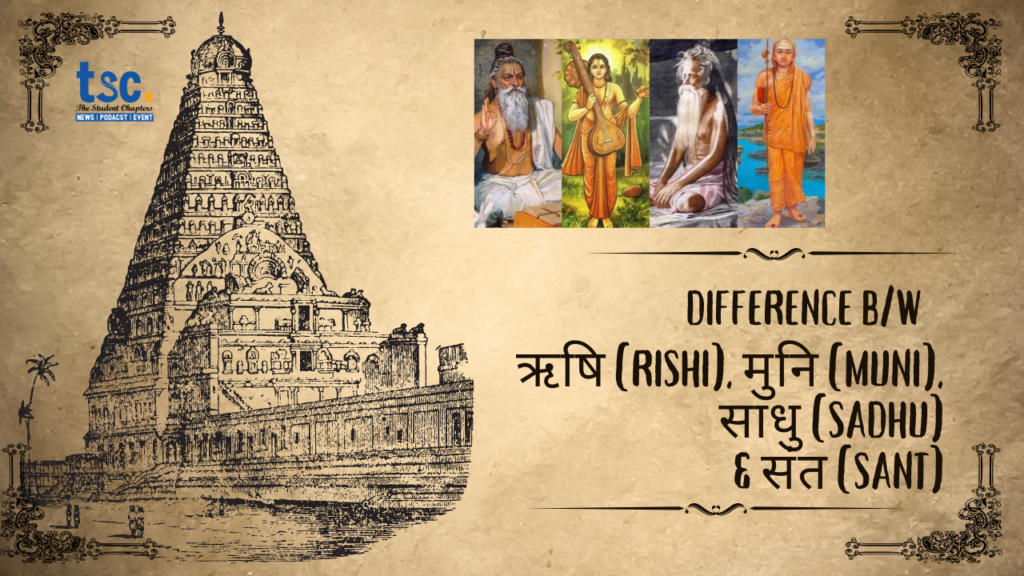Difference Between Rishi, Sadhu, Muni and Sant

Difference Between ऋषि (Rishi), मुनि (Muni), साधु (Sadhu), and संत (Sant)
In Hinduism, the terms ऋषि (Rishi), मुनि (Muni), साधु (Sadhu), and संत (Sant) represent different spiritual personalities, each with unique attributes and roles in guiding people on the path of righteousness:
Here’s a more detailed explanation of ऋषि (Rishi), साधु (Sadhu), मुनि (Muni) and संत (Sant), adding layers of scientific context, research, and clear distinctions of their roles with examples:
1. ऋषि (Rishi):
– Scientific Connection: Rishis were often the ancient equivalents of philosophers, scientists, and intellectuals. In Vedic times, they sought to understand the laws of nature, the universe, and consciousness, often through deep meditation and intellectual contemplation. Their insights were considered revelations from higher cosmic consciousness, akin to what modern-day scientists might call intuitive discoveries or the result of deep thought in scientific inquiry.
– Role in Society: Rishis played a crucial role in ancient Indian society as the transmitters of knowledge. They were the authors or seers of the Vedic hymns and other sacred texts. Their wisdom wasn’t limited to religious matters but extended to natural phenomena, mathematics, astronomy, medicine (Ayurveda), and linguistics. In this sense, Rishis were the intellectuals of ancient Indian civilization.
– Examples:
– Maharishi Patanjali: Known for compiling the Yoga Sutras, contributing significantly to the practice of yoga and meditation.
– Maharishi Kanada: Often regarded as the founder of the atomistic theory of matter, akin to ancient atomic theory.
– Maharishi Bharadwaj: An early researcher into aerodynamics and described mechanical flight in Vedic texts, demonstrating advanced knowledge of aviation, possibly mystical or symbolic, but fascinating to modern-day scientific inquiry.
– Modern Parallels: Today’s scientists, philosophers, or visionary thinkers who use intuition and deep thinking to contribute to fields like cosmology, quantum physics, or consciousness studies are in some ways continuing the Rishi tradition.
2. Sadhu:
– Scientific Connection: Sadhus follow rigorous physical and mental disciplines, which often have a direct impact on their physiology and psychology. Modern research on meditation, fasting, and other ascetic practices shows that they can lead to altered states of consciousness, improved mental focus, and even changes in brain function. For example, studies on meditation and mindfulness show that these practices enhance cognitive function, reduce stress, and increase emotional regulation, which is central to the Sadhu lifestyle.
– Role in Society: Sadhus are ascetics who renounce worldly attachments and dedicate themselves to spiritual pursuits. They practice self-discipline, yoga, and meditation to transcend the ego and material desires. Though often solitary, they serve as spiritual guides for communities, and their detachment symbolizes an ideal of non-materialistic living.
– Examples:
– Sadhguru Jaggi Vasudev: A contemporary example of a Sadhu who, though not fully renounced, practices and teaches yogic traditions and philosophies globally.
– Neem Karoli Baba: A famous Sadhu known for his wisdom and simplicity, revered by figures like Steve Jobs and Mark Zuckerberg.
– Modern Parallels: Those who engage in extensive mindfulness or meditative practices, biohackers who push the limits of human performance through austerity, or modern ascetics living minimalist lives could be seen as modern-day Sadhus.
3. मुनि (Muni)
– Scientific Connection: Munis focus on silence and deep contemplation, engaging in Mauna (vow of silence), which has been shown to impact the brain in profound ways. Studies on silence show that it can stimulate brain cell development, particularly in areas related to memory and emotional regulation. In Munis, the practice of silence allows for deeper introspection, aiding in self-awareness and emotional intelligence, key components in modern psychology’s understanding of mindfulness.
– Role in Society: Unlike Rishis and Sadhus, Munis may not actively seek to communicate their insights or teach others. They dedicate their lives to profound contemplation and inner wisdom, often living solitary lives or staying on the periphery of society. Their silence is a tool for controlling thoughts, accessing inner peace, and transcending the ego.
– Examples:
– Ramana Maharshi: A great Muni of the 20th century who practiced silence and was known for his profound wisdom on self-realization without actively engaging in formal teaching.
– Mahavira: The 24th Tirthankara of Jainism, considered a Muni for his long periods of silence and deep meditative practice.
– Modern Parallels: Contemporary mindfulness practitioners, philosophers who engage in silent retreats, or those who practice deep self-reflection and contemplation, especially within the framework of existential philosophy or Zen Buddhism, are akin to Munis in modern times.
4.संत (Sant): The Saint of Devotion and Service
A Sant is a saintly figure who focuses on devotion, humility, and selfless service as a path to spiritual enlightenment. Unlike Sadhus, who might live in isolation, Sants often live within society, teaching people the importance of love, compassion, and devotion to God. They emphasize that spiritual growth comes from sincere devotion, selfless service to others, and leading a pure, righteous life.
Key Characteristics of a Sant:
- Emphasize love, devotion, and humility.
- Often serve society through spiritual teachings and selfless service.
- Focus on guiding others toward a righteous, devotional path.
- Known for their compassion, purity, and ability to inspire others.
Examples of Sants:
- Sant Kabir, who preached love and unity through his simple yet profound teachings.
- Sant Tukaram, a famous saint and poet known for his devotional songs.
Comparative Analysis with Modern Research:
– Rishi and Science: Rishis were like ancient scientists who sought universal truths through their inner vision and spiritual disciplines. Modern quantum physicists or cosmologists exploring the boundaries of the universe’s origin and existence could be considered analogous to the ancient Rishi.
– Sadhu and Psychology: Sadhus’ practices such as meditation, austerity, and yoga can be linked to modern neuroscience and psychology. These practices reduce cortisol (the stress hormone) and increase grey matter in the brain, as shown in research on long-term meditation practitioners like monks.
– Muni and Mindfulness: Munis’ use of silence and contemplation mirrors the contemporary mindfulness movement, where silence and inward focus help to cultivate awareness, self-regulation, and peace, aligning with findings in cognitive neuroscience that emphasize the benefits of mindfulness on brain health.
Conclusion:
– Rishi is a seer or sage focused on intellectual and spiritual knowledge, often producing teachings that influence societies and later generations.
– Sadhu is an ascetic or holy person, often embodying the principles of renunciation and spiritual practice, serving as an example of non-materialistic life.
– Muni is a contemplative sage who prioritizes silence and inner meditation to access deep wisdom and understanding.
Each figure represents a different pathway in the search for truth and enlightenment, with significant intersections between their ancient practices and modern scientific and psychological findings.
Wondering how to navigate your career journey? Discover expert advice by booking a counseling session today on Mytagapp.com!
Student chapters can be your gateway to success. Uncover their potential in our must-read article and join our student community!









